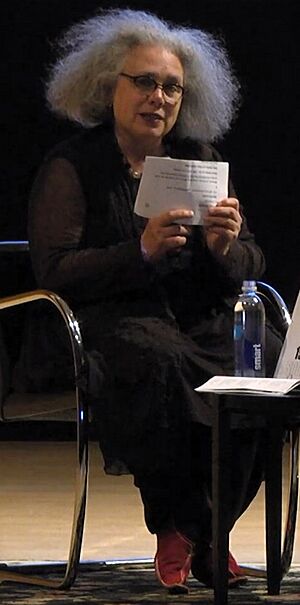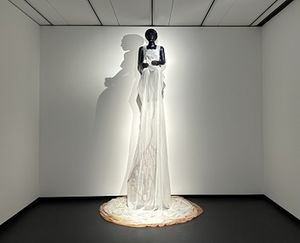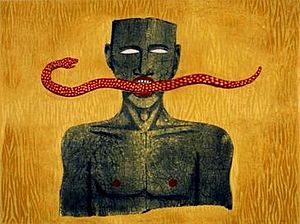Alison Saar facts for kids

Alison Saar (born February 5, 1956) is a talented artist from Los Angeles. She creates sculptures, uses different materials together, and makes large art displays. Her art often explores themes about the African diaspora (people of African descent living around the world) and the identity of Black women. She gets ideas from African, Caribbean, and Latin American folk art and spiritual beliefs.
Alison Saar is famous for taking everyday objects and turning them into art. These artworks then show ideas about culture, identity, history, and religion. Her parents, artist Betye Saar and art restorer Richard Saar, introduced her to art and spiritual ideas early on. Alison and her sisters, Lezley Saar and Tracye Saar-Cavanaugh, all became artists. Alison Saar has shown her art in galleries worldwide and created public art pieces, especially in New York City. She has won awards from places like the New York City Art Commission.
Contents
Growing Up and Learning Art

Alison Saar was born in Los Angeles, California. Her mother, Betye Saar, is a well-known African-American sculptor and installation artist. Her father, Richard Saar, worked with ceramics and restored art. Alison's mother was part of the Black Arts Movement in the 1970s. She often took Alison and her sisters to museums and art shows.
They also saw "Outsider Art," which is art made by people who aren't formally trained. Examples include Simon Rodia's Watts Towers in Los Angeles. Alison loved nature and was fascinated by folk art. She admired how artists could make beautiful things from discarded items. This came from her childhood experiences.
Alison worked with her father as an art restorer for eight years, starting in high school. This is where she learned to carve. She says this experience later influenced the materials she used in her art. Working with old artifacts from different cultures, like Egyptian mummies and African art, taught her about various materials and techniques. Her family continues to be a big part of her art.
Art School and New Ideas
Saar earned two degrees in art history and fine arts from Scripps College in 1978. She then decided she wanted to be an artist, not just study art. Her college thesis focused on African-American folk art. She later earned a master's degree from Otis College of Art and Design in 1981.
At Otis, she made art using fiber, inspired by artists like Mark Rothko. But she soon realized she wanted to create art that was more expressive and engaging. Alison and her mother, Betye Saar, have even created art together, like House of Gris Gris (1989). From her mother, Alison gained an interest in mystery, found objects, and the spiritual power of art.
Starting Her Art Career
After graduating in 1981, Alison Saar and her husband, Tom Leeser, moved to New York City. They turned an old warehouse in Chelsea into their home. The old tin tiles they found in their apartment and other old buildings became a common image in her sculptures.
In 1983, Saar was an artist-in-residence at the Studio Museum in Harlem. She also had a residency in New Mexico in 1985. There, she mixed her city art style with influences from Native American and Mexican art of the Southwest.
Saar lived in New York for 15 years and had two children. She then moved back to Los Angeles, where she lives today.
Her Amazing Artworks
Alison Saar is skilled in many art forms. She creates metal sculptures, wood carvings, frescoes, and woodblock prints. She also makes art using found objects. Her sculptures and art displays explore themes of African culture and spirituality. Her work often tells stories from her own life. It also looks at how the human body shows identity and connects to modern ideas about who we are.
For example, Snake Man (1994) at the Honolulu Museum of Art shows how she uses African culture and the human body in her art. Saar's background, with different cultures and races, and her studies of Latin American, Caribbean, and African art and religions, have shaped her work. She explores practices like Candomblé, Santería, and Hoodoo. She believes that objects hold spirits. She changes everyday found objects to bring out human feelings.
Her sculptures are often life-sized and show strong emotions. She uses different materials and messages to add deep cultural meaning to her art. When asked why she uses found materials, she said she likes how printmaking can be for everyone. She loves the history of "broadsides," where people would print poems and put them all over the city.
Art About Identity
Saar's sculptures often deal with issues about gender and race. She uses both her personal experiences and historical events. Many of her works include messages and themes about African American history. Her 2018 exhibit, Topsy Turvy, refers to a character named Topsy from the book Uncle Tom's Cabin. This character was a harmful stereotype. Saar reimagines Topsy as a symbol of strength and resistance. She shows Topsy as a character who finds love and changes after being treated cruelly as an enslaved person.
Saar says her art is meant to make people feel emotions, but she doesn't always call it "political." However, art critic Roberta Smith once said that Saar's work was one of the few times "the political and visual join forces with real effectiveness." Some of Saar's art directly addresses current events. For example, Rise (2020) is a tribute to the Black Lives Matter Movement. This piece is in the collection of the Whitney Museum of American Art in New York.
Art in Public Places
Saar has created several public artworks. One well-known piece from the early 2000s is a memorial to Harriet Tubman called Swing Low. It's located in Harriet Tubman Memorial Plaza in Harlem, New York City. Saar said she wanted to show Tubman "not as the conductor of the Underground Railroad but as the train itself, an unstoppable locomotive."
In 2011, she had a public collection of works called "Seasons" in Madison Square Park. This included pieces named Spring, Fall, Winter, and Summer. In these pieces, Saar used pomegranates to connect to Greek mythology. She was inspired by the story of Demeter and Persephone, and she wove parts of that tale into her season series.
For the Paris Summer Olympics in 2024, Saar unveiled a new public artwork. It's in the Charles-Aznavour Garden on the city’s Avenue des Champs-Élysées. This monument, called The Salon, shows a Black woman holding an olive branch and a golden flame. She is surrounded by a circle of chairs where people can sit. It represents peace and the strength of women.
Common Ideas in Her Art
Alison Saar often explores certain ideas in her art. These include mythology, girlhood, and family relationships. In an interview, Saar talked about her connection to Yemoja, a Yoruba goddess of childbirth and rivers. She said Yemoja often appears in her work. Saar found Yemoja when she was a young mother trying to balance her family and career. She sees Yemoja as helping her with patience and balance, and as a life-giving spirit that helps her creative process.
Many of Saar’s figures have blank eyes without pupils. Saar explained that these blank eyes are like "masks." They are a way for her figures to keep their dignity, especially during times of slavery. For Saar, the pupil-less eyes mean the figures are not looking back at the viewer. This gives them a sense of control "in times of unimaginable degradation." The way she makes prints also involves "dual worlds" because she has to create the image in reverse. Saar knows a lot about African-diaspora spiritual beliefs. For her, mirrors are like portals, "an invitation to spirit," showing things we might not see with our regular eyes.
Art Shows and Exhibitions

Alison Saar's art has been shown in many museums, galleries, and public places around the world. Some important exhibitions include those at the UCLA Fowler Museum of Cultural History and the L.A. Louver Gallery. She was an artist-in-residence at Dartmouth College and The Studio Museum in Harlem.
Some of her solo exhibitions include: Directions at the Hirshhorn Museum and Sculpture Garden in 1993. Alison Saar: Bearing at the Museum of the African Diaspora in 2015-16. Winter at The Fields Sculpture Park in 2014-15. Hothouse at the Watts Towers Art Center in 2014-15. And STILL... which started at the Ben Maltz Gallery in 2012 and traveled to other museums.
She has also been part of many group exhibitions. These include In Profile: Portraits from the Permanent Collection at The Studio Museum in Harlem in 2015. Also, African American Art since 1950 which traveled to several universities and museums. Her work was also shown at The White House in Washington, D.C., in 1995.
In 2021, an exhibition called Family Legacies: The Art of Betye, Lezley and Alison Saar featured Alison, her mother, and her sister. This show included fifty mixed-media pieces covering over 40 years of their art. The exhibition explored themes like "art, family, and identity" and "reconsidering slavery."
Saar's work Hi, Yella was part of the 1993 Whitney Biennial at the Whitney Museum of American Art. This is a very important exhibition in American art. In 2021, the Benton Museum of Art and Armory Center for the Arts held a joint exhibition of her work called "Alison Saar: Of Aether and Earthe."
Alison Saar is represented by L.A. Louver in Venice, California.
Awards and Honors
Alison Saar has received many awards for her artistic achievements:
- 1984: Artist Fellowship from the National Endowment for the Arts.
- 1985: Engelhard Award from the Institute of Contemporary Art, Boston.
- 1989: Guggenheim Fellowship from the John Simon Guggenheim Memorial Foundation.
- 1998: Joan Mitchell Foundation Award.
- 1999: Distinguished Alumnus of the Year from Otis College of Art and Design.
- 2003: Distinguished Alumna Award from Scripps College.
- 2005: Excellence in Design Award by the New York City Art Commission.
- 2012: Fellow of United States Artists.
- 2013: Joan Mitchell Foundation.
- City of Los Angeles (C.O.L.A.) Artist Fellowship.
Where to See Her Art
Alison Saar's art is part of the permanent collections in many museums, including:
- Museum of Modern Art, New York
- Indianapolis Museum of Art, Indianapolis, IN
- Museum of Fine Arts, Houston, TX
- Brooklyn Museum, Brooklyn, NY
See also
 In Spanish: Alison Saar para niños
In Spanish: Alison Saar para niños
- York: Terra Incognita (2010), Lewis & Clark College, Portland, Oregon


